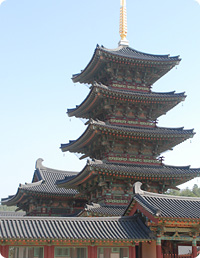EXCURSIONS
Central Korea (A) 4 days
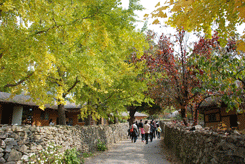
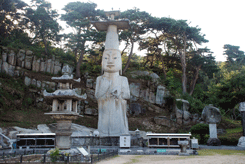
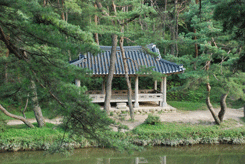
Tour Highlights
- Sosuseowon Confucian Academy
- Ginseng Market
- Hahoemaeul Village
- Beopjusa Temple
- Gungnamji Pond
- Jeongrimsa Pagoda
- Buyeo National Museum
- Busosan Fortress
- Gongju National Museum
- Songsanri Tombs
- Hwaseong Fortress
Click on the days to access the program quick
| Days | Visits and Activities | Distance |
| Day 1 | Seoul - Danyang - Punggi - Andong | 270km |
| Day 2 | Andong - Songnisan | 140km |
| Day 3 | Songnisan - Buyeo | 130km |
| Day 4 | Buyeo - Gongju - Suwon - Seoul | 180km |
Day 1 Seoul - Yeongju - Punggi - Andong (- - -) 270km
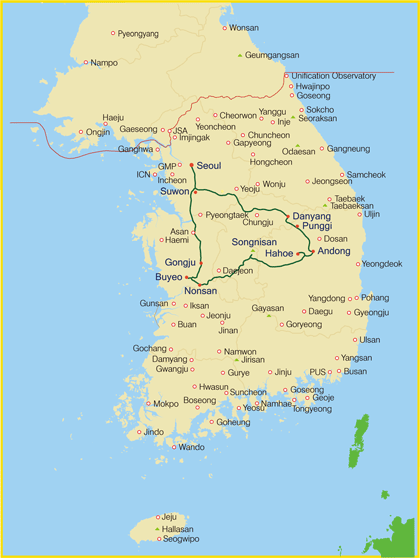 Your tour guide will greet you in your hotel in Seoul and takes you on a countryside excursion. You will tour the
Sosuseowon. It is the first private institute established in Korea, and was a birthplace of Confucian education and a cradle of prominent scholars. It was established by Ju Se-bung in 1543 and named Baekundong Seowon. The compound itself is composed of two sections; academic studies and research, and memorial service. There are several old buildings where scholars learned and studied loyalty, filial piety, manners and knowledge. The institute has a Shrine, which was built to enshrine An Hyang, An Bo, An Chuk and Je Se-bung, where a memorial service takes place twice a year on the first day of the third and ninth months by the lunar calendar.
Your tour guide will greet you in your hotel in Seoul and takes you on a countryside excursion. You will tour the
Sosuseowon. It is the first private institute established in Korea, and was a birthplace of Confucian education and a cradle of prominent scholars. It was established by Ju Se-bung in 1543 and named Baekundong Seowon. The compound itself is composed of two sections; academic studies and research, and memorial service. There are several old buildings where scholars learned and studied loyalty, filial piety, manners and knowledge. The institute has a Shrine, which was built to enshrine An Hyang, An Bo, An Chuk and Je Se-bung, where a memorial service takes place twice a year on the first day of the third and ninth months by the lunar calendar.
While in Punggi, a small remote town famous for quality apples and ginseng, stop off at ginseng market with piles of fresh ginseng roots, including variety array of ginseng products. This mysterious root, which has a good smell better than it tastes, has historically been considered an empowering medicine and a cure-all. Street vendors sell flowers, fruits, food stuff and home grown grains and vegetables. With all these features combined creates a rural ambience of Korea's remote town.
Day 2 Andong - Songnisan (B) 140km
You will explore UNESCO World Heritage Site, Hahoemaeul from the 15th century. It is the best preserved traditional village portraying and spanning the life of the Joseon Dynasty (1392-1910) and some 480 Korean traditional houses, both large and small, are still fully functioning.
As you take a walk in the narrow alleys, enjoy the rustic and old charm of this unique village. You cannot possibly miss a 600-years old zelkova tree, the home to the village spirit. At the tree's base is where residents still make their wishes. The village is also known for traditional festival, Hahoe Mask Dance which gave common people the opportunity to mock those in authority, and in particular the Byeolsingut, a shaman ritual exorcising evil spirits, dating back to the Goryeo dynasty (918-1392).
Your journey continues to Songnisan national park, weaving through the picturesque countryside. En route, make a short stop at a 600-year-old pine tree shaped like an open umbrella. In recent years several branches were damaged by wind and snow, though what remains is still beautiful. Upon entering Beopjusa dating back to 553, you will certainly stand in awe before the enormous golden Buddha gazing down at the temple and a five-story wooden pagoda, the only one left in Korea. Check out a giant iron pot whose diameter is 2.7 meters that may well had been used to feed 3,000 priests in the early 12th century. A stone carved lantern supported by twin lions standing face to face is a rare example of the magnificent Silla sculptures. A stone water cistern is considered unique for beauty and design. Two stone pillars once held the temple banner pole. An excellent carved relief called Maaebul and worship halls also can be seen.
You cannot miss Four Buddhist Instrument Ceremony. The sounds of each instrument, Brahma bell, Dharma drum, wooden fish and cloud-shaped gong, have a function in saving beings of other realms. Hearing them reverberating through the universe, you will reflect upon the profound symbolism of the instruments. It is a great vow to save or enlighten the creatures in the universe including those on land, in the sea, in the air and in hell.
Day 3 Songnisan - Buyeo (B) 130km
Buyeo is a melting pot of Baekje culture which is often regarded as the most artistically sophisticated of the Three Kingdoms. Today, you will explore archaeological sites and ancient historic areas, which were collectively named as a UNESCO World Heritage sites. Gungnamji is the Korea's oldest artificial pond dating back to 634. Ringed by weeping willow trees, it creates a colorful spectacle with its stock of water lotuses in summer. Jeongrimsa temple site with its five-storied stone pagoda recalling the glorious past is one of the city's most distinctive and outstanding landmarks.
At Buyeo National Museum, you will feel the spirit and the essence of the brilliant Baekje culture as you appreciate the beauty of the archaeological relics. A beautiful gilt bronze incense burner is impossible to miss. Crafted over 1,500 years ago, it shows a graceful dignity and the elaborate skills of Baekje craftsmen.
Stroll up paths to Busosan to explore Baekje fortification. At the top of the hill sits Yeongillu pavilion where the king once came to watch the sun rise over his kingdom.
A little further down the trail, you will see a pavilion called Baekhwajeong perched at the top of the rock beside which locates Nakhwaam, literally meaning Falling Flower Rock, on a bluff overlooking the Geum River at the bend called Baekma. As enemies swarmed into the capital, the court ladies flung themselves into the water from this bluff rather than suffer the shame of submitting to atrocities of the conquering enemy armies.
Day 4 Buyeo - Gongju - Suwon - Seoul (B) 180km
Gongju is a charming city that once served as the Baekje's capital for 63 years from 475 to 538. Visit Gongju National Museum and get a glimpse of the fascinating archaeological articles from Baekje era, and artifacts excavated from the royal tomb of King Muryeong (501-524), one of the last rulers to reign in the capital of Gongju.
Near museum is UNESCO Heritage site of Songsanri Tombs, a group of royal tombs that just look like a cluster of grassy knolls. The tomb which belongs to King Muryeong (462-523) and his wife, the queen was found completely intact since it was sealed in the early 6th century. The actual tomb was permanently closed, but you will see an excellent, albeit miniature duplicate.
While in Suwon, explore UNESCO World Heritage site of Hwaseong Fortress from the 18th century. Though it is relatively small in scale, it is well acknowledged as the best structure of its kind ever built in Korea. A 5.74km-long fortress enclosing both flatland and hilly terrain is parapeted with crenels and merlons and highlighted by four main gates and well over 50 structures including temporary palace where the king sought refuge during war and found rest during times of peace. A walk through the whole fortress could take several hours but it is well worth making a short walking tour to enjoy the splendor of the fortress, including the Korea's largest Janganmun Gate.





